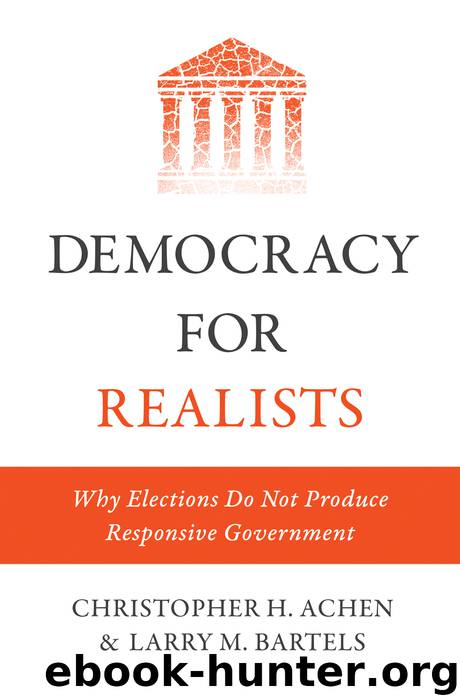Democracy for Realists by Achen Christopher H. Bartels Larry M

Author:Achen, Christopher H.,Bartels, Larry M.
Language: eng
Format: epub
Publisher: Princeton University Press
Published: 2016-08-18T16:00:00+00:00
Figure 7.4. Depression and Recovery in Eight Countries, 1928–1940
In the United States, the resulting New Deal realignment replaced a profoundly conservative government with a liberal—critics would say radical—alternative. The shift seems entirely interpretable along ideological lines. Moreover, the subsequent recovery of the national economy seems to validate the efficacy of Roosevelt’s dramatic policy innovations: real income per capita increased by a remarkable 46% over the years from 1932 to 1940.32 However, the story seems a good deal less simple when we canvass the responses of electorates in other established democracies to the economic crises documented in figure 7.4.
Around the world, electoral reactions to the Depression produced momentous realignments of established party systems in a bewildering variety of configurations. Incumbent governments were deposed with impressive consistency during the worst days of the Depression, regardless of their ideologies. And new incumbents who presided over robust economic recoveries were rewarded with long runs in office—again, regardless of their ideologies:
• In Canada, voters punished the incumbent Liberal Party in 1930, giving the Conservative Party a comfortable parliamentary majority. However, the new Conservative government could do nothing to stem the economic tide; real income continued to plummet and unemployment continued to escalate through 1931, 1932, and 1933 (just as they did in the United States). Economic conditions improved in 1934 and 1935 (again, just as they did in the United States), but when the Conservative government stood for reelection in 1935 unemployment still hovered near 20%. The voters responded by punishing the Conservatives even more vigorously than they had punished the Liberals in 1930, and the Liberals, who had been repudiated by the voters only five years earlier, won nearly three-fourths of the seats in the new Parliament. Economic conditions continued to improve steadily through the rest of the decade. By 1940, unemployment was below its 1930 level and real income was 40% higher than it had been a decade earlier. The Liberal government was returned with overwhelming parliamentary majorities in 1940, and again in 1945, 1949, and 1953 before finally falling in 1957.
• In Australia the economy declined precipitously in 1930–31, either despite or because of the “radical” policies of the incumbent Labor Party. In the general election of 1931, Labor was challenged by the newly founded United Australia Party, a coalition of conservative nationalists and Labor dissidents. Labor’s vote share fell from 49% (winning 46 House seats) in 1929 to 27% (winning 14 House seats) in 1931. The United Australia Party won with 40% of the vote, the economy improved markedly, and UAP held power through three subsequent elections in the next decade.
• In Britain, a minority Labour government took office in 1929 but pursued orthodox policies and a balanced budget. By the end of 1930, unemployment had more than doubled and the value of exports had fallen by half. A plan to bolster the Exchequer through massive cuts in unemployment relief divided the Labour Party, leading Prime Minister Ramsay MacDonald to form a multiparty National Government in 1931 to impose austerity. The
Download
This site does not store any files on its server. We only index and link to content provided by other sites. Please contact the content providers to delete copyright contents if any and email us, we'll remove relevant links or contents immediately.
The Secret History by Donna Tartt(18849)
The Social Justice Warrior Handbook by Lisa De Pasquale(12142)
Thirteen Reasons Why by Jay Asher(8796)
This Is How You Lose Her by Junot Diaz(6795)
Weapons of Math Destruction by Cathy O'Neil(6146)
Zero to One by Peter Thiel(5686)
Beartown by Fredrik Backman(5599)
The Myth of the Strong Leader by Archie Brown(5425)
The Fire Next Time by James Baldwin(5249)
How Democracies Die by Steven Levitsky & Daniel Ziblatt(5128)
Promise Me, Dad by Joe Biden(5087)
Stone's Rules by Roger Stone(5026)
A Higher Loyalty: Truth, Lies, and Leadership by James Comey(4845)
100 Deadly Skills by Clint Emerson(4840)
Rise and Kill First by Ronen Bergman(4704)
Secrecy World by Jake Bernstein(4646)
The David Icke Guide to the Global Conspiracy (and how to end it) by David Icke(4626)
The Farm by Tom Rob Smith(4438)
The Doomsday Machine by Daniel Ellsberg(4416)
